Jun Hu
NVIDIA, Duke University
IntrinsicNGP: Intrinsic Coordinate based Hash Encoding for Human NeRF
Mar 09, 2023Abstract:Recently, many works have been proposed to utilize the neural radiance field for novel view synthesis of human performers. However, most of these methods require hours of training, making them difficult for practical use. To address this challenging problem, we propose IntrinsicNGP, which can train from scratch and achieve high-fidelity results in few minutes with videos of a human performer. To achieve this target, we introduce a continuous and optimizable intrinsic coordinate rather than the original explicit Euclidean coordinate in the hash encoding module of instant-NGP. With this novel intrinsic coordinate, IntrinsicNGP can aggregate inter-frame information for dynamic objects with the help of proxy geometry shapes. Moreover, the results trained with the given rough geometry shapes can be further refined with an optimizable offset field based on the intrinsic coordinate.Extensive experimental results on several datasets demonstrate the effectiveness and efficiency of IntrinsicNGP. We also illustrate our approach's ability to edit the shape of reconstructed subjects.
Experimental observation on a low-rank tensor model for eigenvalue problems
Feb 01, 2023



Abstract:Here we utilize a low-rank tensor model (LTM) as a function approximator, combined with the gradient descent method, to solve eigenvalue problems including the Laplacian operator and the harmonic oscillator. Experimental results show the superiority of the polynomial-based low-rank tensor model (PLTM) compared to the tensor neural network (TNN). We also test such low-rank architectures for the classification problem on the MNIST dataset.
SelfNeRF: Fast Training NeRF for Human from Monocular Self-rotating Video
Oct 04, 2022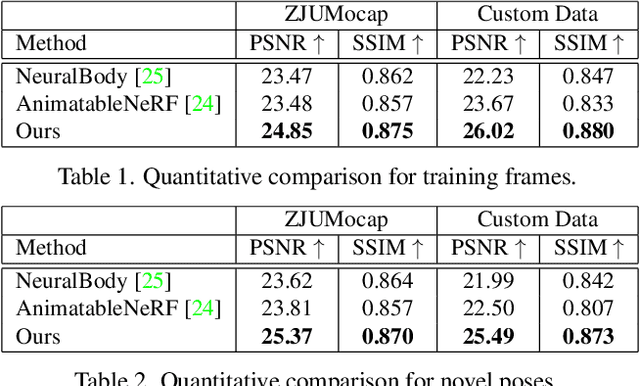



Abstract:In this paper, we propose SelfNeRF, an efficient neural radiance field based novel view synthesis method for human performance. Given monocular self-rotating videos of human performers, SelfNeRF can train from scratch and achieve high-fidelity results in about twenty minutes. Some recent works have utilized the neural radiance field for dynamic human reconstruction. However, most of these methods need multi-view inputs and require hours of training, making it still difficult for practical use. To address this challenging problem, we introduce a surface-relative representation based on multi-resolution hash encoding that can greatly improve the training speed and aggregate inter-frame information. Extensive experimental results on several different datasets demonstrate the effectiveness and efficiency of SelfNeRF to challenging monocular videos.
A total hip surgery robot system based on intelligent positioning and optical measurement
Jun 15, 2022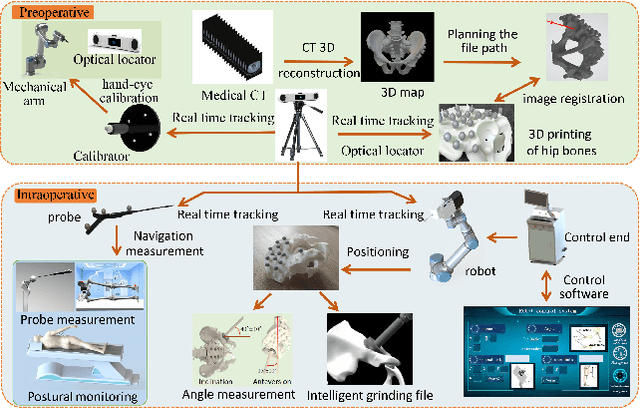
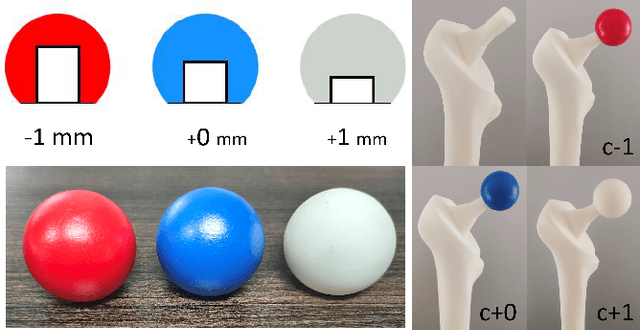
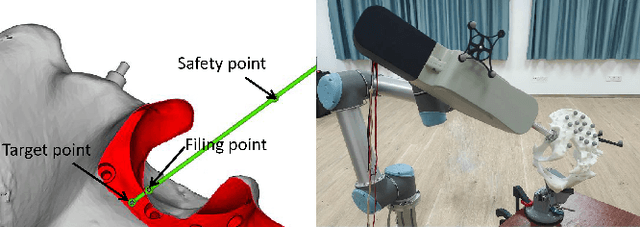
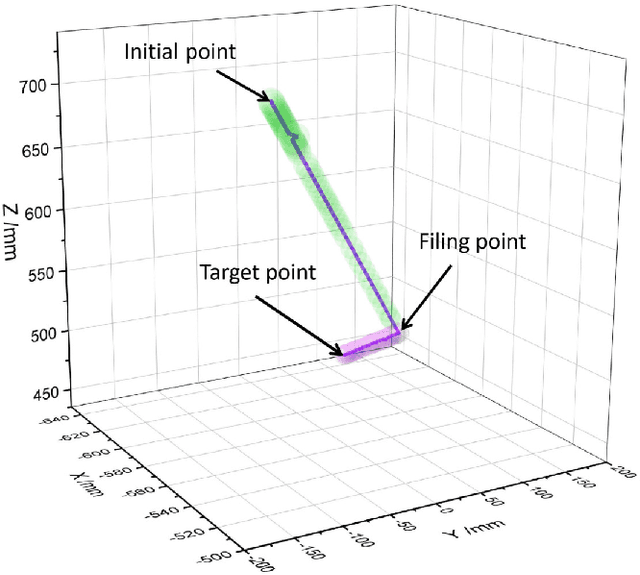
Abstract:This paper represents the development and experimental evaluation of an autonomous navigation surgical robot system for total hip arthroplasty (THA). Existing robotic systems used in joint replacement surgery have achieved good clinical results, with reported better accuracy. While the surgeon needs to locate the robot arm to the target position during the operation, which is easily affected by the doctor of experience. Yet, the hand-hold acetabulum reamer is easy to appear with uneven strength and grinding file. Further, the lack of steps to measure the femoral neck length may lead to poor results.To tackle this challenge, our design contains the real-time traceable optical positioning strategy to reduce unnecessary manual adjustments to the robotic arm during surgery, the intelligent end-effector system to stable the grinding, and the optical probe to provide real-time measurement of femoral neck length and other parameters to choose the prosthesis. The length of the lower limbs was measured as the prosthesis was installed. Experimental evaluation showed that the robot of precision, execution ability, and robustness are better than expected.
Real-time Hyper-Dimensional Reconfiguration at the Edge using Hardware Accelerators
Jun 10, 2022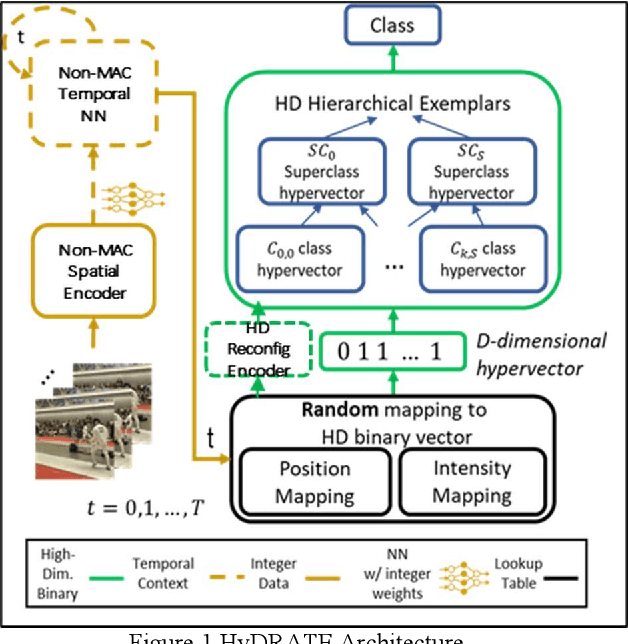
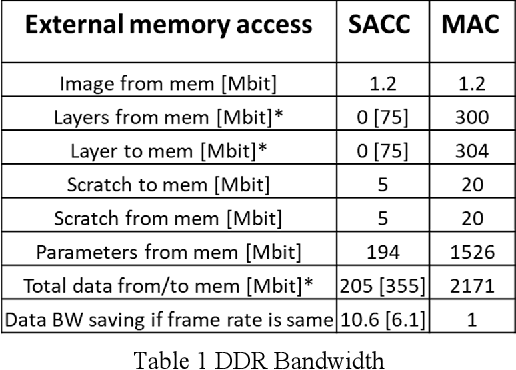

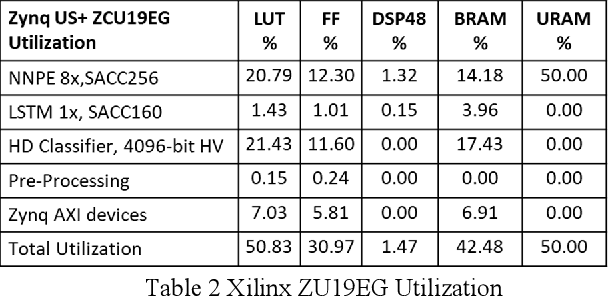
Abstract:In this paper we present Hyper-Dimensional Reconfigurable Analytics at the Tactical Edge (HyDRATE) using low-SWaP embedded hardware that can perform real-time reconfiguration at the edge leveraging non-MAC (free of floating-point MultiplyACcumulate operations) deep neural nets (DNN) combined with hyperdimensional (HD) computing accelerators. We describe the algorithm, trained quantized model generation, and simulated performance of a feature extractor free of multiply-accumulates feeding a hyperdimensional logic-based classifier. Then we show how performance increases with the number of hyperdimensions. We describe the realized low-SWaP FPGA hardware and embedded software system compared to traditional DNNs and detail the implemented hardware accelerators. We discuss the measured system latency and power, noise robustness due to use of learnable quantization and HD computing, actual versus simulated system performance for a video activity classification task and demonstration of reconfiguration on this same dataset. We show that reconfigurability in the field is achieved by retraining only the feed-forward HD classifier without gradient descent backpropagation (gradient-free), using few-shot learning of new classes at the edge. Initial work performed used LRCN DNN and is currently extended to use Two-stream DNN with improved performance.
MGDCF: Distance Learning via Markov Graph Diffusion for Neural Collaborative Filtering
Apr 05, 2022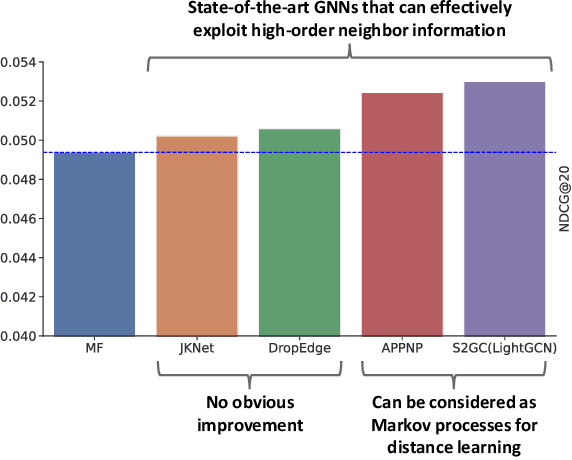

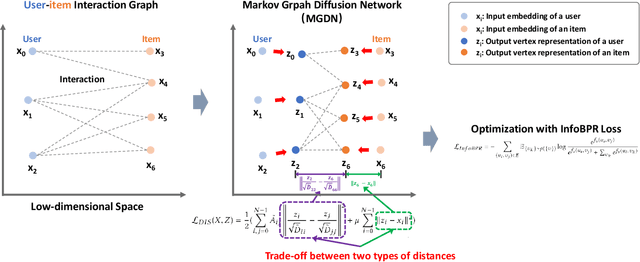

Abstract:Collaborative filtering (CF) is widely used by personalized recommendation systems, which aims to predict the preference of users with historical user-item interactions. In recent years, Graph Neural Networks (GNNs) have been utilized to build CF models and have shown promising performance. Recent state-of-the-art GNN-based CF approaches simply attribute their performance improvement to the high-order neighbor aggregation ability of GNNs. However, we observe that some powerful deep GNNs such as JKNet and DropEdge, can effectively exploit high-order neighbor information on other graph tasks but perform poorly on CF tasks, which conflicts with the explanation of these GNN-based CF research. Different from these research, we investigate the GNN-based CF from the perspective of Markov processes for distance learning with a unified framework named Markov Graph Diffusion Collaborative Filtering (MGDCF). We design a Markov Graph Diffusion Network (MGDN) as MGDCF's GNN encoder, which learns vertex representations by trading off two types of distances via a Markov process. We show the theoretical equivalence between MGDN's output and the optimal solution of a distance loss function, which can boost the optimization of CF models. MGDN can generalize state-of-the-art models such as LightGCN and APPNP, which are heterogeneous GNNs. In addition, MGDN can be extended to homogeneous GNNs with our sparsification technique. For optimizing MGDCF, we propose the InfoBPR loss function, which extends the widely used BPR loss to exploit multiple negative samples for better performance. We conduct experiments to perform detailed analysis on MGDCF. The source code is publicly available at https://github.com/hujunxianligong/MGDCF.
DRTAM: Dual Rank-1 Tensor Attention Module
Mar 11, 2022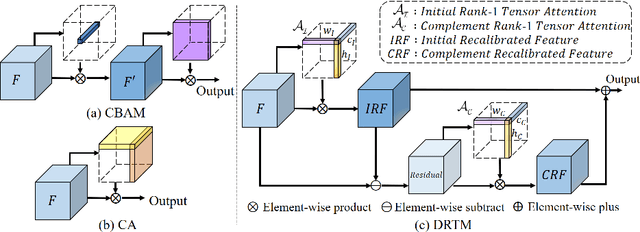
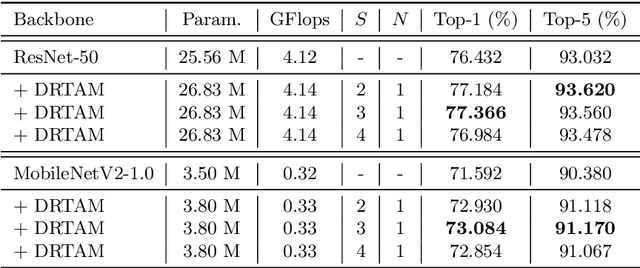
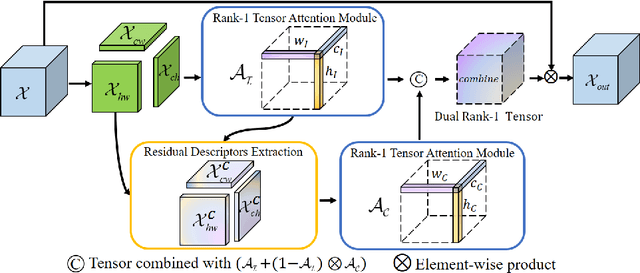
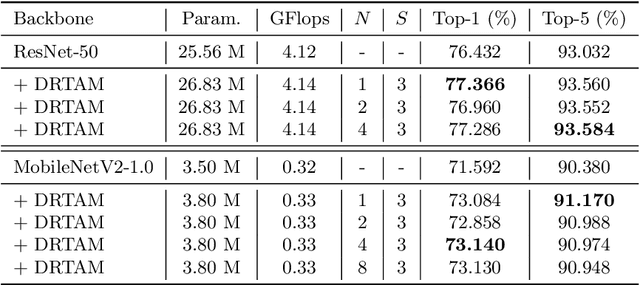
Abstract:Recently, attention mechanisms have been extensively investigated in computer vision, but few of them show excellent performance on both large and mobile networks. This paper proposes Dual Rank-1 Tensor Attention Module (DRTAM), a novel residual-attention-learning-guided attention module for feed-forward convolutional neural networks. Given a 3D feature tensor map, DRTAM firstly generates three 2D feature descriptors along three axes. Then, using three descriptors, DRTAM sequentially infers two rank-1 tensor attention maps, the initial attention map and the complement attention map, combines and multiplied them to the input feature map for adaptive feature refinement(see Fig.1(c)). To generate two attention maps, DRTAM introduces rank-1 tensor attention module (RTAM) and residual descriptors extraction module (RDEM): RTAM divides each 2D feature descriptors into several chunks, and generate three factor vectors of a rank-1 tensor attention map by employing strip pooling on each chunk so that local and long-range contextual information can be captured along three dimension respectively; RDEM generates three 2D feature descriptors of the residual feature to produce the complement attention map, using three factor vectors of the initial attention map and three descriptors of the input feature. Extensive experimental results on ImageNet-1K, MS COCO and PASCAL VOC demonstrate that DRTAM achieves competitive performance on both large and mobile networks compare with other state-of-the-art attention modules.
GRecX: An Efficient and Unified Benchmark for GNN-based Recommendation
Dec 03, 2021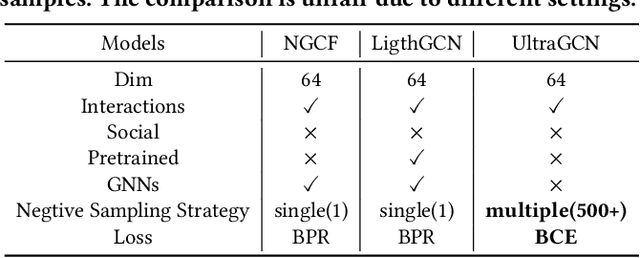
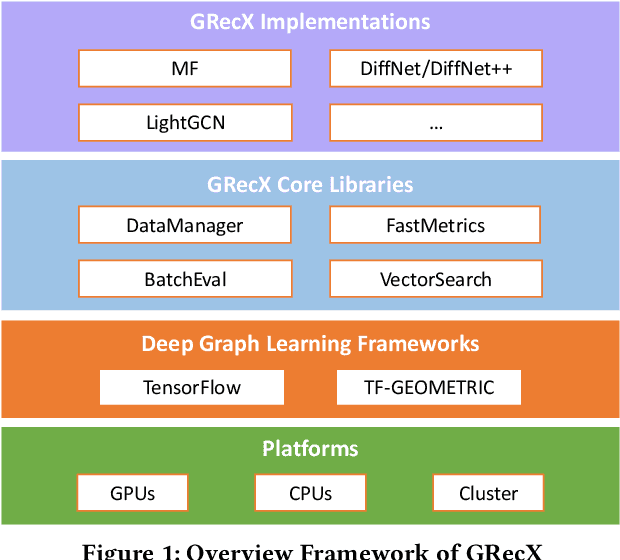

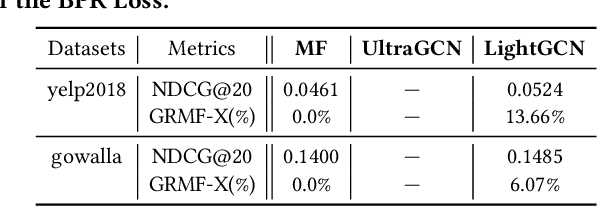
Abstract:In this paper, we present GRecX, an open-source TensorFlow framework for benchmarking GNN-based recommendation models in an efficient and unified way. GRecX consists of core libraries for building GNN-based recommendation benchmarks, as well as the implementations of popular GNN-based recommendation models. The core libraries provide essential components for building efficient and unified benchmarks, including FastMetrics (efficient metrics computation libraries), VectorSearch (efficient similarity search libraries for dense vectors), BatchEval (efficient mini-batch evaluation libraries), and DataManager (unified dataset management libraries). Especially, to provide a unified benchmark for the fair comparison of different complex GNN-based recommendation models, we design a new metric GRMF-X and integrate it into the FastMetrics component. Based on a TensorFlow GNN library tf_geometric, GRecX carefully implements a variety of popular GNN-based recommendation models. We carefully implement these baseline models to reproduce the performance reported in the literature, and our implementations are usually more efficient and friendly. In conclusion, GRecX enables uses to train and benchmark GNN-based recommendation baselines in an efficient and unified way. We conduct experiments with GRecX, and the experimental results show that GRecX allows us to train and benchmark GNN-based recommendation baselines in an efficient and unified way. The source code of GRecX is available at https://github.com/maenzhier/GRecX.
Contrastive Adaptive Propagation Graph Neural Networks for Efficient Graph Learning
Dec 02, 2021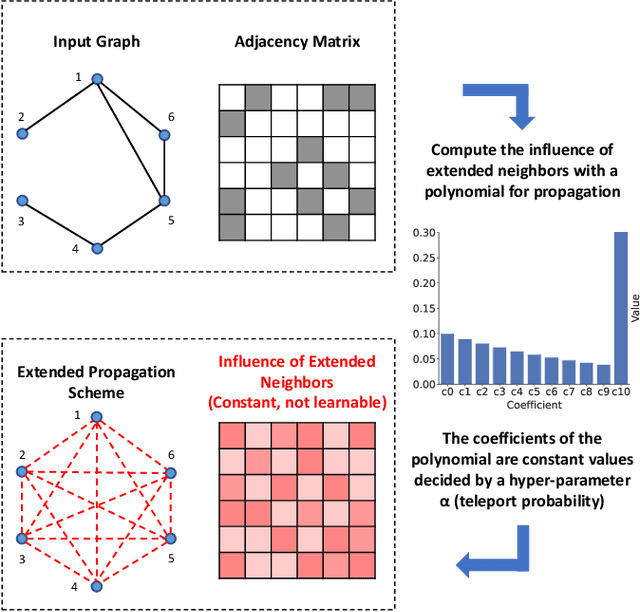

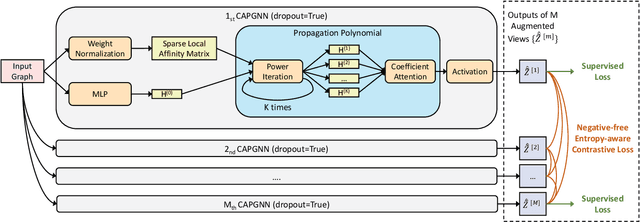

Abstract:Graph Neural Networks (GNNs) have achieved great success in processing graph data by extracting and propagating structure-aware features. Existing GNN research designs various propagation schemes to guide the aggregation of neighbor information. Recently the field has advanced from local propagation schemes that focus on local neighbors towards extended propagation schemes that can directly deal with extended neighbors consisting of both local and high-order neighbors. Despite the impressive performance, existing approaches are still insufficient to build an efficient and learnable extended propagation scheme that can adaptively adjust the influence of local and high-order neighbors. This paper proposes an efficient yet effective end-to-end framework, namely Contrastive Adaptive Propagation Graph Neural Networks (CAPGNN), to address these issues by combining Personalized PageRank and attention techniques. CAPGNN models the learnable extended propagation scheme with a polynomial of a sparse local affinity matrix, where the polynomial relies on Personalized PageRank to provide superior initial coefficients. In order to adaptively adjust the influence of both local and high-order neighbors, a coefficient-attention model is introduced to learn to adjust the coefficients of the polynomial. In addition, we leverage self-supervised learning techniques and design a negative-free entropy-aware contrastive loss to explicitly take advantage of unlabeled data for training. We implement CAPGNN as two different versions named CAPGCN and CAPGAT, which use static and dynamic sparse local affinity matrices, respectively. Experiments on graph benchmark datasets suggest that CAPGNN can consistently outperform or match state-of-the-art baselines. The source code is publicly available at https://github.com/hujunxianligong/CAPGNN.
Adaptive Convolutions with Per-pixel Dynamic Filter Atom
Aug 17, 2021

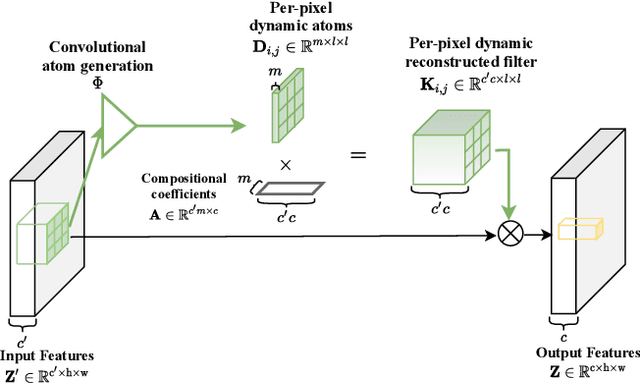

Abstract:Applying feature dependent network weights have been proved to be effective in many fields. However, in practice, restricted by the enormous size of model parameters and memory footprints, scalable and versatile dynamic convolutions with per-pixel adapted filters are yet to be fully explored. In this paper, we address this challenge by decomposing filters, adapted to each spatial position, over dynamic filter atoms generated by a light-weight network from local features. Adaptive receptive fields can be supported by further representing each filter atom over sets of pre-fixed multi-scale bases. As plug-and-play replacements to convolutional layers, the introduced adaptive convolutions with per-pixel dynamic atoms enable explicit modeling of intra-image variance, while avoiding heavy computation, parameters, and memory cost. Our method preserves the appealing properties of conventional convolutions as being translation-equivariant and parametrically efficient. We present experiments to show that, the proposed method delivers comparable or even better performance across tasks, and are particularly effective on handling tasks with significant intra-image variance.
 Add to Chrome
Add to Chrome Add to Firefox
Add to Firefox Add to Edge
Add to Edge